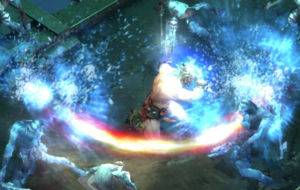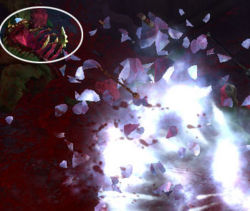Combat
Combat is the main activity engaged in while playing games in the Diablo series; they're not known as click-fests for nothing. Diablo isn't an RPG with a lot of social activities, or professions, or NPC dialogue. It's about killing vast hordes of evil monsters. Every class in Diablo III is a DPS class; all are capable of prolifically slaying the enemies, whether by spells, skills, brute force, or a clever combination of all three.
Aspects of combat are addressed throughout this wiki. Weapons and Skills are detailed, Monsters are described, Strategies are promoted, and more. This page covers the basics of combat, and how the game is designed to facilitate it, with numerous quotes from the D3 Team.
Damage Types
As in previous games in the series, there are various types of damage in Diablo III. Various spells, skills, and weapons channel their destructive might into one (or more) types of damage. Characters and monsters counter these attacks with equivalent types of resistance and immunities, and players must find the right balance of each if they wish to succeed in their battles.
Damage in Diablo III takes the following forms. Every form of damage can count for a Critical hit (caused by various item or skill properties) and when a "crit" is landed, a bonus effect is added along with increased damage.
- Physical Damage:
- Critical hit: Deals double damage. Might also knockback, but not confirmed.
- Arcane Damage: Purple in coloration.
- Critical hit: Arcane crits "silence" targets. (Silenced targets can not cast some spells, such as a Skeletal Summoner or Goatman Shaman resurrecting fallen minions.)
- Cold Damage: Blue in coloration.
- Critical hit: Cold crits freeze targets for 2 seconds.
- Fire Damage: Red in coloration.
- Critical hit: Fire crits set targets ablaze, adding DoT to the initial fire damage.
- Lightning Damage: White in coloration.
- Critical hit: Lightning crits stun targets for 2 seconds.
- Toxic Damage: Green in coloration.
- Critical hit: Toxic (poison) crits deal an unknown bonus.
Information Through Graphics

- Bashiok: A lot of the effects that you make factor in to the abilities that the characters are using, so fire and arcane and all that stuff, but in the world of Diablo it seems like there are very specific magic types that exist... it is actually a pretty broad spectrum, but is there any limitation there to what you can do with different damage types?
- Julian: Yeah in fact that’s a common input that I’ll receive is “Hey this guy’s a fiery this or whatever, but can we make that fire look green?” And that’s where the sort of designer in me has to kind of come out and say, wait a minute if we make fire green all of a sudden it’s a bit of a miscommunication in terms of the gameplay. And so there is a bit of constraint there that, at one point I’m trying to make things look as epic as they can, but at the same time they have to be really clear to the player so that they’re not confused that you know, green fire might mean poison. Then there’s the other part of it which is it’s really easy in my department to make a big mess. We can just clobber the screen with so many effects that you just can’t see the game anymore. So those are really the two constraints we really work with most.
Critical Hit Visuals
Critical hits inflict extra damage and/or bonus effects (detailed above). Various skills and items can improve the odds of a critical hit, as well as the damage it deals. Other skills or item effects trigger each time a critical hit is scored, creating an interesting and interconnected system of damage bonuses.
Critical hits existed in Diablo II, but they were indicated only by a small sparkle of white light. That concept has been vastly upgraded in Diablo III. Now, when a Monster takes a "crit" there's a dramatic graphical effect, especially if the death is due to crits. Monsters so slain literally explode, shattering into gory chunks that fly across the screen and litter the ground. These animations are customized for whatever type of damage killed them; flames will be seen on the hunks of meat if the critical was fire-based, sparks rise from lightning, etc. Physical damage crits leave huge slicks of blood and give a battlefield a lovely post-massacre patina.
- See the Critical hits page for much more detail.
In Depth Combat
One criticism of earlier games in the series is that they are fairly one-dimensional, in terms of combat. One or two skills can be used over and over again, in almost every situation, and there's little thought required. This was especially the case in Diablo II, where players were nearly god-like in their powers and could easily escape almost any dangerous situation by running or teleporting away. The D3 Team wants to make combat much more tactical in D3; it will still be a fast-paced, click-intensive Action RPG, but there should be a bit more strategy required than "click til dead."
Jay Wilson talked about the shallowness of combat in D2, and his plans to deepen it in D3 with 1up.com in December 2008.
- The combat model doesn't have a lot of depth in the previous games. It was very much a "one-skill spam" kind of game, which I think works great for the Normal [difficulty] playthrough. I think most of the audience is just fine with that, and through most of the Normal difficulty, it's going to be like that. But as you go into Nightmare and Hell difficulties, I think that the more serious player will appreciate a game that's a little deeper on the combat-mechanic side.
- 1up.com: What makes Diablo 3's combat deeper than its predecessors?
- Jay Wilson: Combat is as deep as the options the designers give themselves. Whenever you add a new capability to a monster -- potentially something that feels unbeatable -- it's more of an opportunity to expand the depth of your characters so they can respond to those threats. A good example would be if you look at Diablo 2: There were a couple of problems with just the power of the characters and the way they were made powerful. A player could run faster than any monster, so you could escape just about any threat. You had endless health and resource -- by resource, I mean mana -- because of potions. And you had the Town Portal, which could instantly get you out of any problem. Those were incredibly powerful mechanics to escape danger and were not class-specific. So every kind of class really had no need for anything like an escape skill or reactionary ability. They simply needed to attack, and if they ever got in over their heads, they simply ran away or drank potions. And it's the same response across the board.
- So one of the things we focused on is that response -- 1) setting up scenarios where the players can't easily get out of danger without the use of class-specific skills, and 2) giving them really simple controls to use a broader range of skills without making the game that much more complex to play. I really distinguish the difference between complexity and depth; to me, complexity is adding more buttons, while depth is making a single button more powerful and versatile. So that's always been our goal -- reducing the amount of controls while making each button mean more. So that's one of the reasons we added the Hotbar; it's one of the reasons why we avoided the potion-health system. And when people play the game, they may not notice this next point that much, but we leveled out the movement speed somewhat so that the player moves at a more reasonable rate compared to the monsters.

